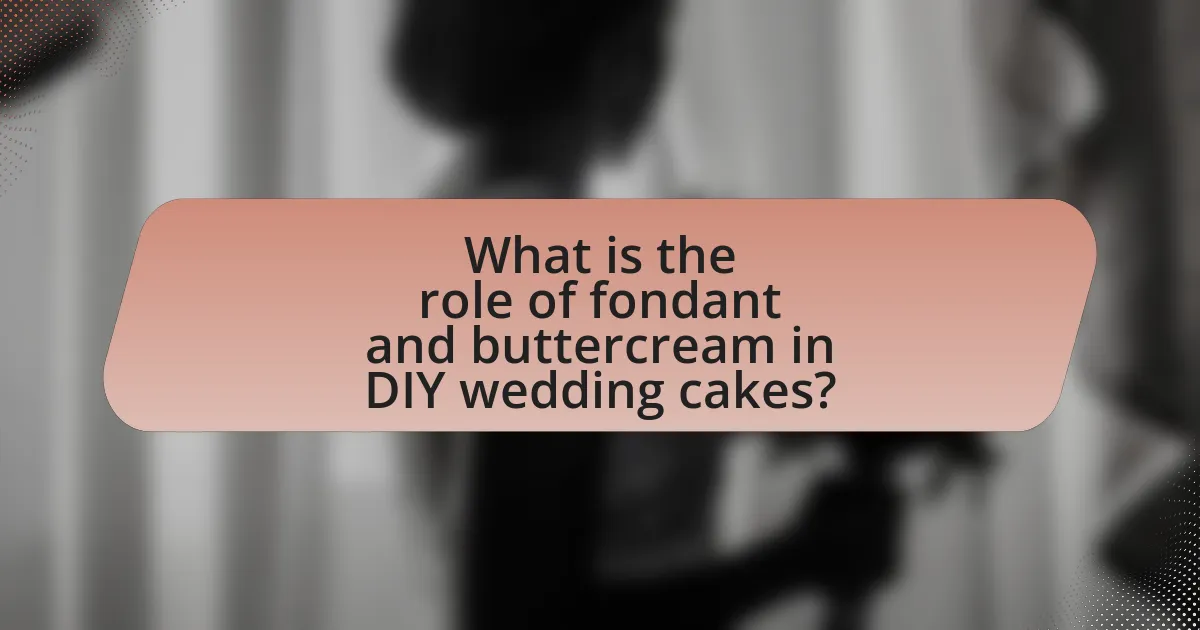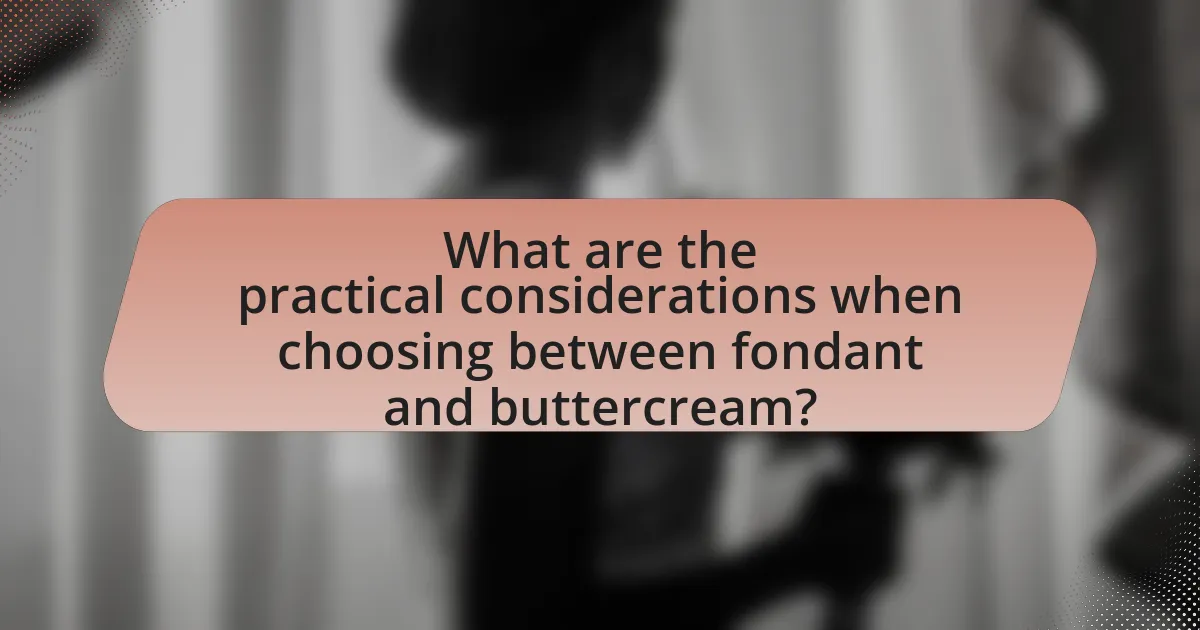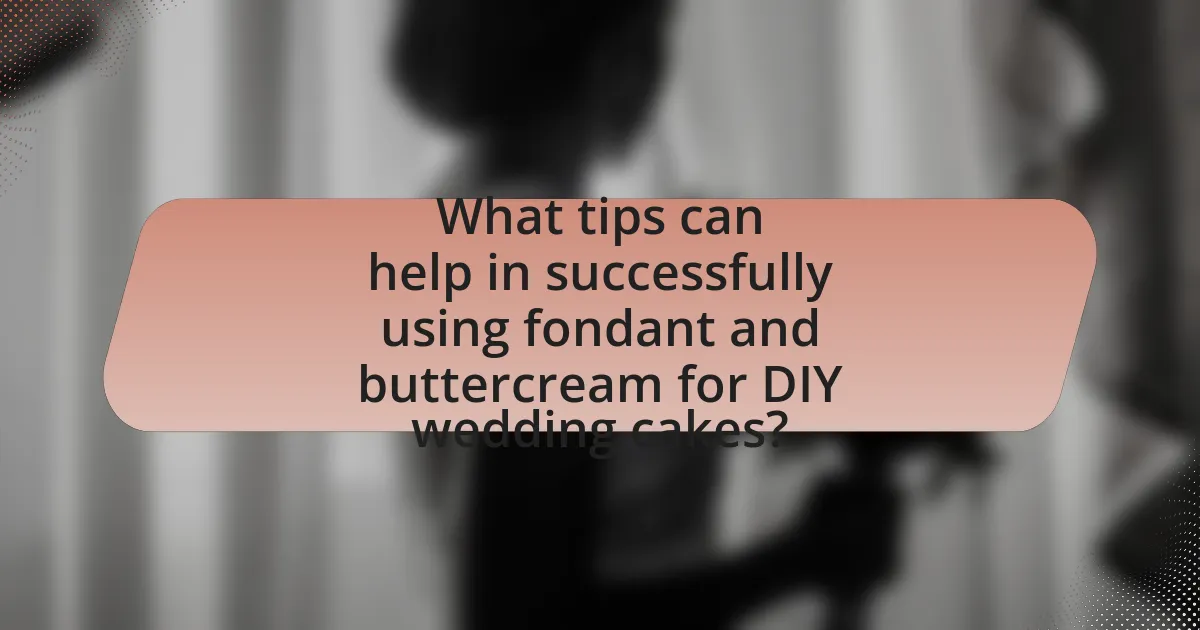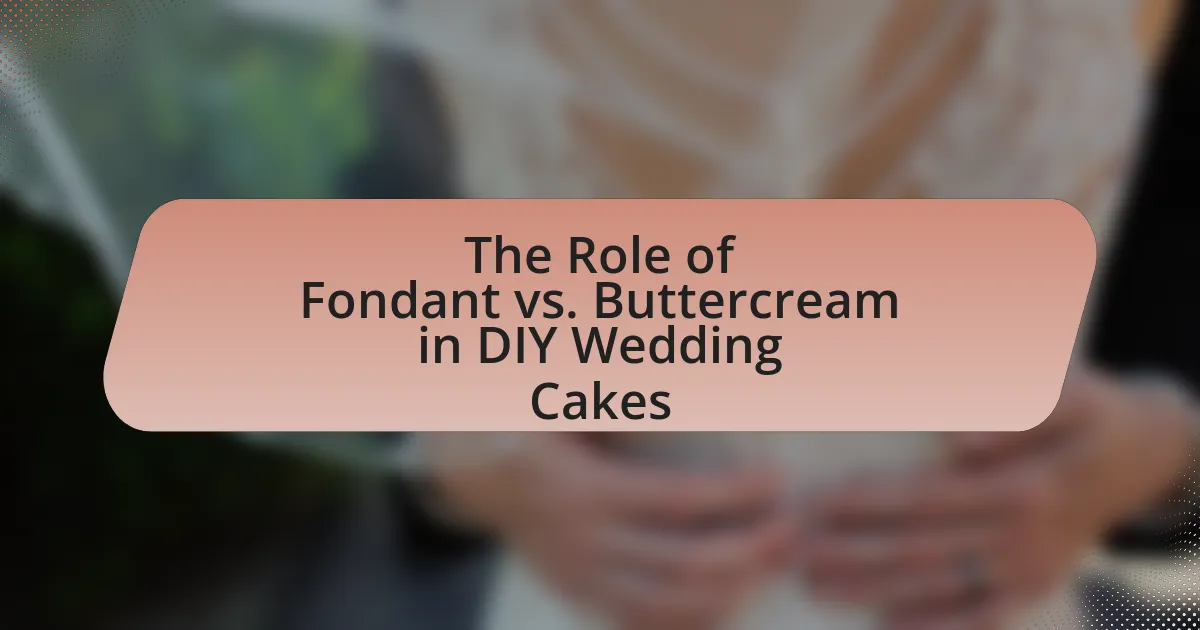The article examines the distinct roles of fondant and buttercream in DIY wedding cakes, highlighting their unique characteristics, textures, and flavors. Fondant is noted for its smooth, polished finish and ability to create intricate designs, while buttercream is recognized for its rich flavor and creamy texture. The discussion includes practical considerations for choosing between the two, including cost, availability, and storage, as well as techniques for decorating with each medium. Additionally, the article provides troubleshooting tips and best practices for achieving optimal results when working with fondant and buttercream in cake design.

What is the role of fondant and buttercream in DIY wedding cakes?
Fondant and buttercream serve distinct yet complementary roles in DIY wedding cakes. Fondant is primarily used for creating a smooth, polished exterior that enhances the cake’s aesthetic appeal, allowing for intricate designs and decorations. In contrast, buttercream acts as a flavorful filling and frosting, providing moisture and richness to the cake while also serving as an adhesive for fondant layers. The combination of both allows bakers to achieve a visually stunning cake that is also delicious, as fondant can be rolled out to cover the cake while buttercream can be piped for decorative elements.
How do fondant and buttercream differ in texture and taste?
Fondant and buttercream differ significantly in both texture and taste. Fondant has a smooth, pliable texture that allows it to be rolled out and draped over cakes, creating a sleek finish, while buttercream is creamy and fluffy, providing a rich, sweet flavor that is often used for frosting and filling. The taste of fondant is generally more neutral and slightly sweet, primarily due to its sugar content, whereas buttercream offers a buttery, sweet flavor that can be enhanced with various extracts or flavors. This distinction in texture and taste influences their use in cake decoration and flavor profiles in DIY wedding cakes.
What are the unique characteristics of fondant?
Fondant is a smooth, pliable icing made primarily from sugar, water, and gelatin, which allows it to be rolled out and draped over cakes for a polished finish. Its unique characteristics include a glossy appearance, the ability to create intricate designs and shapes, and a firm texture that can hold its form, making it ideal for sculpting decorations. Additionally, fondant can be flavored and colored, providing versatility in cake design. Its use in professional cake decorating is supported by its historical prevalence in high-end pastry arts, where it has been favored for its aesthetic qualities and ability to create a seamless look on wedding cakes.
What are the unique characteristics of buttercream?
Buttercream is a creamy frosting made primarily from butter and sugar, known for its smooth texture and rich flavor. Its unique characteristics include versatility in flavoring, ease of spreading and piping, and the ability to create a variety of finishes on cakes. Buttercream can be easily colored and flavored with extracts, making it suitable for different cake designs and themes. Additionally, it has a soft consistency that allows for intricate decorations, yet it can also be whipped to a stiffer texture for more structured designs. The sugar content in buttercream contributes to its sweetness and stability, allowing it to hold its shape when applied to cakes.
Why are fondant and buttercream popular choices for wedding cakes?
Fondant and buttercream are popular choices for wedding cakes due to their versatility and aesthetic appeal. Fondant provides a smooth, polished finish that allows for intricate designs and decorations, making it ideal for elegant wedding themes. Buttercream, on the other hand, offers a rich flavor and creamy texture that many couples prefer for taste. According to a survey by The Knot, 60% of couples choose buttercream for its flavor, while fondant is favored for its visual presentation. This combination of taste and appearance makes both fondant and buttercream highly sought after in wedding cake design.
What aesthetic advantages does fondant provide?
Fondant provides a smooth, polished finish that enhances the visual appeal of cakes. This characteristic allows for intricate designs, sharp edges, and a variety of textures that are difficult to achieve with buttercream. Additionally, fondant can be easily colored and molded into decorative shapes, enabling cake decorators to create elaborate themes and personalized designs for weddings. The versatility of fondant in achieving a flawless appearance makes it a preferred choice for many DIY wedding cakes.
What flavor benefits does buttercream offer?
Buttercream offers a rich, creamy flavor that enhances the overall taste of cakes and desserts. This flavor profile is achieved through the combination of butter, sugar, and often additional flavorings such as vanilla or cocoa, which contribute to its sweetness and depth. The texture of buttercream also allows it to complement various cake flavors, making it versatile for different types of wedding cakes. Additionally, buttercream can be easily flavored or colored, providing customization options that align with wedding themes and personal preferences.
How do fondant and buttercream affect cake design and decoration?
Fondant and buttercream significantly influence cake design and decoration by offering distinct textures and aesthetic possibilities. Fondant provides a smooth, polished finish that allows for intricate designs, such as sharp edges and detailed decorations, making it ideal for formal wedding cakes. In contrast, buttercream offers a softer, more textured appearance that can be piped into various shapes and swirls, lending itself to a more rustic or casual style. The choice between these two mediums affects not only the visual appeal but also the flavor and mouthfeel of the cake, as fondant is often less flavorful than buttercream. This distinction is crucial for bakers to consider when designing cakes that align with the desired theme and taste preferences for events like weddings.
What techniques are used for decorating with fondant?
Techniques used for decorating with fondant include rolling, draping, molding, and painting. Rolling involves flattening fondant to cover cakes smoothly, while draping allows for elegant folds and textures. Molding is used to create intricate shapes and figures, enhancing the cake’s design. Painting with edible colors adds detail and personalization, making the cake visually appealing. These techniques are widely recognized in cake decorating, as they enable bakers to achieve professional-looking results.
What techniques are used for decorating with buttercream?
Techniques used for decorating with buttercream include piping, smoothing, and painting. Piping involves using a piping bag fitted with various tips to create decorative borders, flowers, and intricate designs. Smoothing is achieved by applying an offset spatula or bench scraper to create a clean, polished finish on the cake’s surface. Painting with buttercream can involve using food coloring to create artistic designs directly on the cake. These techniques are widely recognized in cake decorating, as they allow for versatility and creativity in presentation.

What are the practical considerations when choosing between fondant and buttercream?
When choosing between fondant and buttercream for DIY wedding cakes, practical considerations include texture, taste, and ease of use. Fondant provides a smooth, polished finish ideal for intricate designs, while buttercream offers a rich flavor and creamy texture that many prefer. Additionally, fondant can be more challenging to work with due to its drying time and requires specific techniques for application, whereas buttercream is generally easier to spread and can be piped into various decorations. Temperature sensitivity is another factor; buttercream can melt in warm conditions, while fondant can withstand heat better but may become sticky. Ultimately, the choice depends on the desired aesthetic, flavor preference, and skill level of the baker.
How do cost and availability influence the choice of fondant or buttercream?
Cost and availability significantly influence the choice between fondant and buttercream for DIY wedding cakes. Fondant is generally more expensive due to its ingredients and the additional skill required for application, while buttercream is more affordable and widely available. For instance, a 5-pound bucket of buttercream can cost around $15, whereas a similar quantity of fondant may range from $30 to $50. Additionally, buttercream is easier to find in local grocery stores, making it a more accessible option for many bakers. This cost disparity and availability often lead DIY bakers to prefer buttercream for budget-friendly and straightforward cake designs.
What are the typical costs associated with fondant and buttercream?
The typical costs associated with fondant range from $2 to $5 per pound, while buttercream costs approximately $1 to $3 per pound. These price differences are influenced by factors such as ingredients, preparation time, and regional pricing variations. For instance, fondant requires more specialized ingredients and labor-intensive preparation, contributing to its higher cost compared to buttercream, which is simpler to make and requires fewer ingredients.
Where can you source quality fondant and buttercream for DIY cakes?
Quality fondant and buttercream for DIY cakes can be sourced from specialty baking supply stores, online retailers like Amazon and Etsy, and local bakeries that offer wholesale options. Specialty baking supply stores often carry a variety of brands known for their quality, such as Satin Ice for fondant and Cakery Craft for buttercream. Online platforms provide access to a wider range of products, including organic and vegan options, catering to diverse dietary needs. Local bakeries may also sell high-quality products directly to consumers, ensuring freshness and supporting local businesses.
What are the storage and shelf-life differences between fondant and buttercream?
Fondant has a longer shelf life and can be stored at room temperature, while buttercream has a shorter shelf life and typically requires refrigeration. Fondant can last for several months when stored in a cool, dry place, as it is less prone to spoilage due to its sugar content. In contrast, buttercream, which contains dairy products, generally lasts about one to two weeks in the refrigerator and can be frozen for up to three months, but its texture may change upon thawing. These differences are crucial for planning the storage of wedding cakes, as fondant allows for more flexibility in preparation and decoration timelines.
How should fondant be stored for optimal freshness?
Fondant should be stored in an airtight container at room temperature to maintain its optimal freshness. This method prevents exposure to air, which can cause fondant to dry out and harden. Additionally, it is important to keep fondant away from direct sunlight and heat sources, as these can also negatively affect its texture and pliability. Proper storage ensures that fondant remains soft and workable for decorating cakes, which is crucial for achieving the desired aesthetic in DIY wedding cakes.
How should buttercream be stored for optimal freshness?
Buttercream should be stored in an airtight container in the refrigerator for optimal freshness. This method helps to maintain its texture and flavor by preventing exposure to air and moisture, which can lead to spoilage. When stored properly, buttercream can last for up to two weeks in the refrigerator. For longer storage, it can be frozen for up to three months; however, it should be thawed in the refrigerator before use to preserve its consistency.

What tips can help in successfully using fondant and buttercream for DIY wedding cakes?
To successfully use fondant and buttercream for DIY wedding cakes, ensure that the cake layers are completely cooled and leveled before applying any frosting. This prevents bulging and uneven surfaces. Additionally, use a thin layer of buttercream as a crumb coat to seal in crumbs and create a smooth base for fondant application. When rolling out fondant, dust the surface with cornstarch or powdered sugar to prevent sticking, and aim for a thickness of about 1/8 inch for optimal coverage. For a polished finish, use a fondant smoother to eliminate air bubbles and achieve a sleek appearance. These techniques are supported by professional cake decorators who emphasize the importance of preparation and technique in achieving a flawless cake design.
What are the best practices for working with fondant?
The best practices for working with fondant include ensuring a clean and dry surface, using cornstarch or powdered sugar to prevent sticking, and kneading the fondant until it is pliable. A clean surface is essential to avoid contamination and ensure smooth application. Cornstarch or powdered sugar acts as a non-stick agent, allowing for easy rolling and shaping without tearing. Kneading the fondant properly enhances its elasticity, making it easier to work with and reducing the likelihood of cracks. Additionally, using a rolling pin with guides can help achieve an even thickness, which is crucial for a professional finish.
How can you prevent fondant from cracking or tearing?
To prevent fondant from cracking or tearing, ensure it is properly conditioned and rolled to the right thickness. Proper conditioning involves kneading the fondant until it is pliable and smooth, which helps maintain its elasticity. Rolling the fondant to a thickness of about 1/8 inch allows it to stretch without breaking. Additionally, avoid exposing fondant to extreme temperatures or humidity, as these conditions can lead to drying or excessive moisture absorption, both of which contribute to cracking. Using cornstarch or powdered sugar while rolling can also help reduce stickiness and prevent tearing.
What tools are essential for fondant decoration?
Essential tools for fondant decoration include a rolling pin, fondant smoother, sharp knife or pizza cutter, and various shaping tools such as fondant molds and cutters. The rolling pin is crucial for evenly rolling out the fondant to the desired thickness, while the fondant smoother helps achieve a flawless finish on the cake surface. A sharp knife or pizza cutter is necessary for precise cutting and trimming of fondant edges. Additionally, shaping tools like molds and cutters allow for the creation of intricate designs and decorations, enhancing the overall aesthetic of the cake. These tools are widely recognized in cake decorating practices, ensuring effective and professional results in fondant applications.
What are the best practices for working with buttercream?
The best practices for working with buttercream include ensuring the butter is at room temperature, using a stand mixer for optimal mixing, and incorporating powdered sugar gradually to achieve a smooth consistency. Room temperature butter allows for better aeration, resulting in a lighter texture. A stand mixer provides consistent mixing, which is crucial for achieving the right fluffiness. Gradually adding powdered sugar prevents clumping and ensures even distribution, leading to a creamy and spreadable buttercream. These practices are essential for creating a stable buttercream that holds its shape, especially important in the context of DIY wedding cakes where presentation is key.
How can you achieve the perfect buttercream consistency?
To achieve the perfect buttercream consistency, combine equal parts of softened butter and powdered sugar, then gradually add milk or cream until the desired texture is reached. This method ensures a smooth and spreadable buttercream that holds its shape. The ratio of butter to sugar is crucial; typically, a 1:2 ratio of butter to sugar yields a stable consistency suitable for decorating cakes. Additionally, incorporating a small amount of vanilla extract enhances flavor without affecting the texture.
What are common troubleshooting tips for buttercream icing?
Common troubleshooting tips for buttercream icing include adjusting the consistency, temperature, and flavor balance. If the icing is too stiff, adding a small amount of milk or cream can help achieve a smoother texture. Conversely, if the icing is too runny, incorporating additional powdered sugar will thicken it. For buttercream that appears grainy, beating it longer can help create a smoother finish. If the icing is melting, it may be too warm; chilling it briefly can restore its structure. Lastly, if the flavor is too sweet, adding a pinch of salt or a splash of vanilla extract can enhance the overall taste. These tips are based on common practices in baking and cake decorating, ensuring effective solutions for typical buttercream issues.
